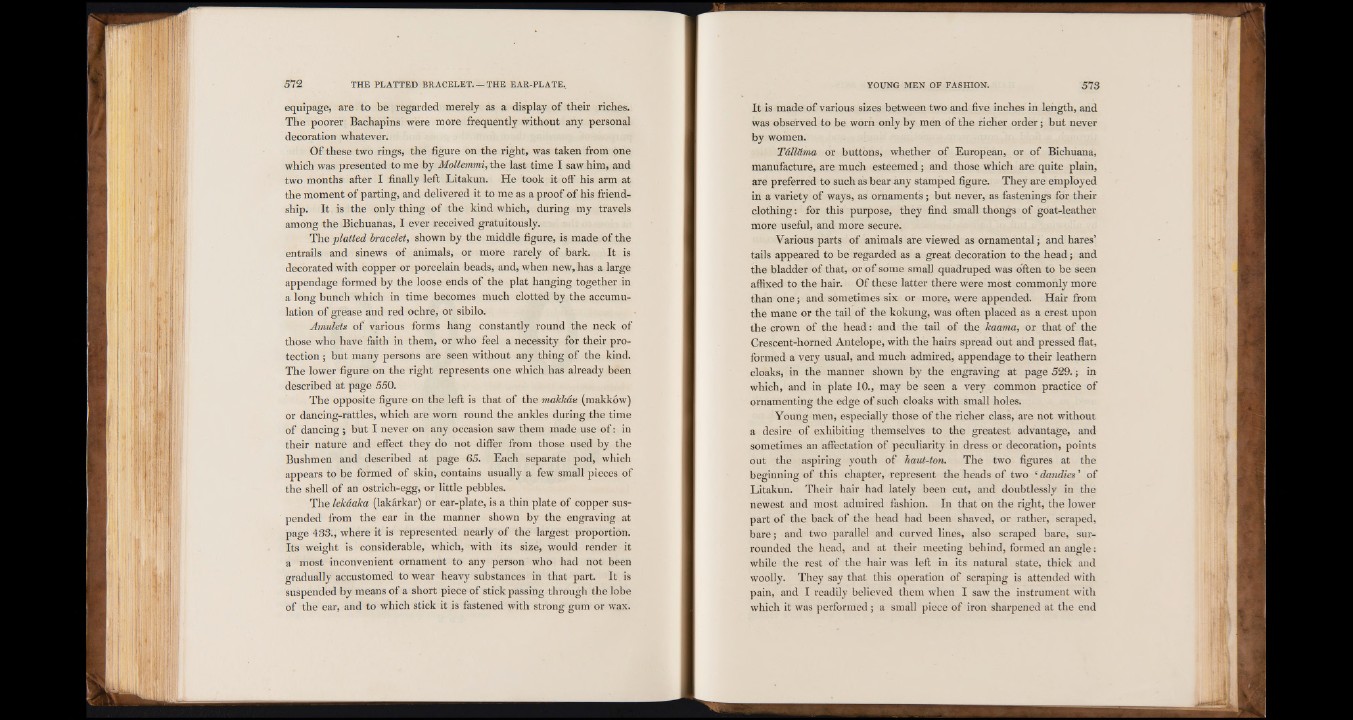
572 THE PLATTED BRACELET. — THE EAR-PLATE,
equipage, are to be regarded merely as a display of their riches.
The poorer Bachapins were more frequently without any personal
decoration whatever.
Of these two rings, the figure on the right, was taken from one
which was presented to me by Mollemmi, the last time I saw him, and
two months after I finally left Litakun. He took it off his arm at
the moment of parting, and delivered it to me as a proof of his friendship.
It is the only thing of the kind which, during my travels
among the Bichuanas, I ever received gratuitously.
The platted bracelet, shown by the middle figure, is made of the
entrails and sinews of animals, or more rarely of bark. It is
decorated with copper or porcelain beads, and, when new, has a large
appendage formed by the loose ends of the plat hanging together in
a long bunch which in time becomes much clotted by the accumulation
of grease and red ochre, or sibilo.
Amulets of various forms hang constantly round the neck of
those who have faith in them, or who feel a necessity for their protection
; but many persons are seen without any thing of the kind.
The lower figure on the right represents one which has already been
described at page 550.
The opposite figure on the left is that of the makkde (makkow)
or dancing-rattles, which are worn round the ankles during the time
of dancing ; but I never on any occasion saw them made use o f: in
their nature and effect they do not differ from those used by the
Bushmen and described at page 65. Each separate pod, which
appears to be formed of skin, contains usually a few small pieces of
the shell of an ostrich-egg, or little pebbles.
The lekaaka (lakarkar) or ear-plate, is a thin plate of copper suspended
from the ear in the manner shown by the engraving at
page 433., where it is represented nearly of the largest proportion.
Its weight is considerable, which, with its size, would render it
a most inconvenient ornament to any person who had not been
gradually accustomed to wear heavy substances in that part. It is
suspended by means of a short piece of stick passing through the lobe
of the ear, and to which stick it is fastened with strong gum or wax.
YOUNG MEN OF FASHION. 573
It is made of various sizes between two and five inches in length, and
was observed to be worn only by men of the richer order; but never
by women.
Talldma or buttons, whether of European, or of Bichuana,
manufacture, are much esteemed; and those which are quite plain,
are preferred to such as bear any stamped figure. They are employed
in a variety of ways, as ornaments; but never, as fastenings for their
clothing: for this purpose, they find small thongs of goat-leather
more useful, and more secure.
Various parts of animals are viewed as ornamental; and hares’
tails appeared to be regarded as a great decoration to the head; and
the bladder of that, or of some small quadruped was often to be seen
affixed to the hair. Of these latter there were most commonly more
than one; and sometimes six or more, were appended. Hair from
the mane or the tail of the kokung, was often placed as a crest upon
the crown of the head: and the tail of the kaama, or that of the
Crescent-horned Antelope, with the hairs spread out and pressed flat,
formed a very usual, and much admired, appendage to their leathern
cloaks, in the manner shown by the engraving at page 529.; in
which, and in plate 10., may be seen a very common practice of
ornamenting the edge of such cloaks with small holes.
Young men, especially those of the richer class, are not without
a desire of exhibiting themselves to the greatest advantage, and
sometimes an affectation of peculiarity in dress or decoration, points
out the aspiring youth of haut-ton. The two figures at the
beginning of this chapter, represent the heads of two ‘ dandies’ of
Litakun. Their hair had lately been cut, and doubtlessly in the
newest and most admired fashion. In that on the right, the lower
part of the back of the head had been shaved, or rather, scraped,
bare; and two parallel and curved lines, also scraped bare, surrounded
the head, and at their meeting behind, formed an angle:
while the rest of the hair was left in its natural state, thick and
woolly. They say that this operation of scraping is attended with
pain, and I readily believed them when I saw the instrument with
which it was performed ; a small piece of iron sharpened at the end